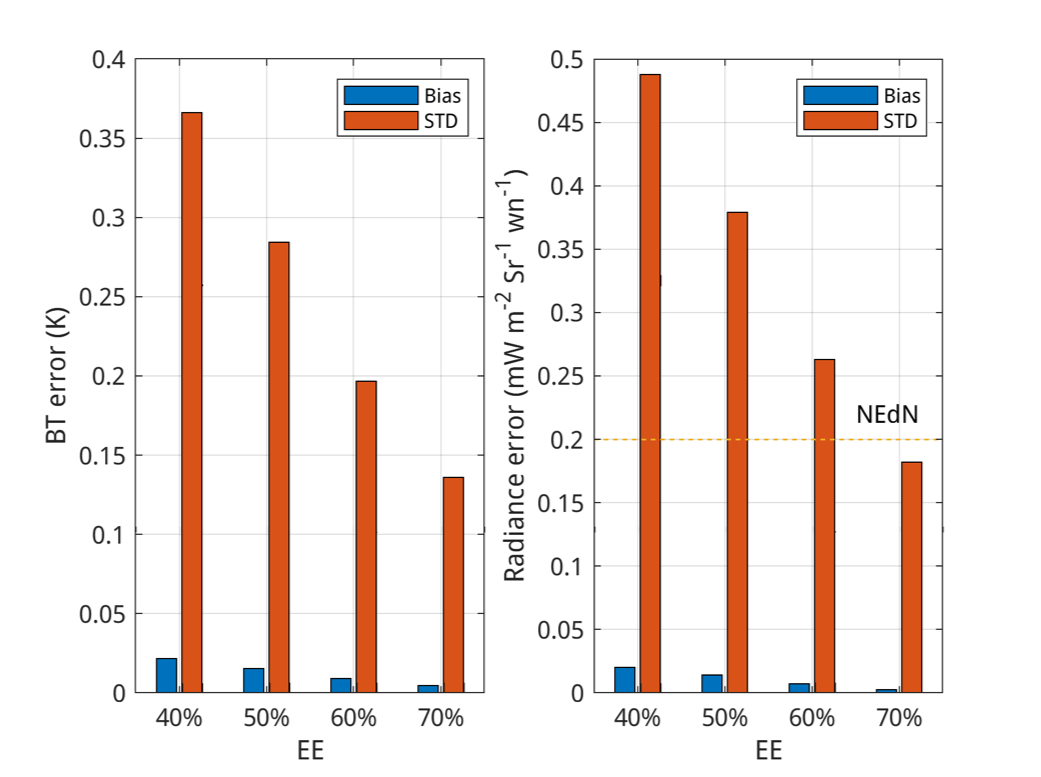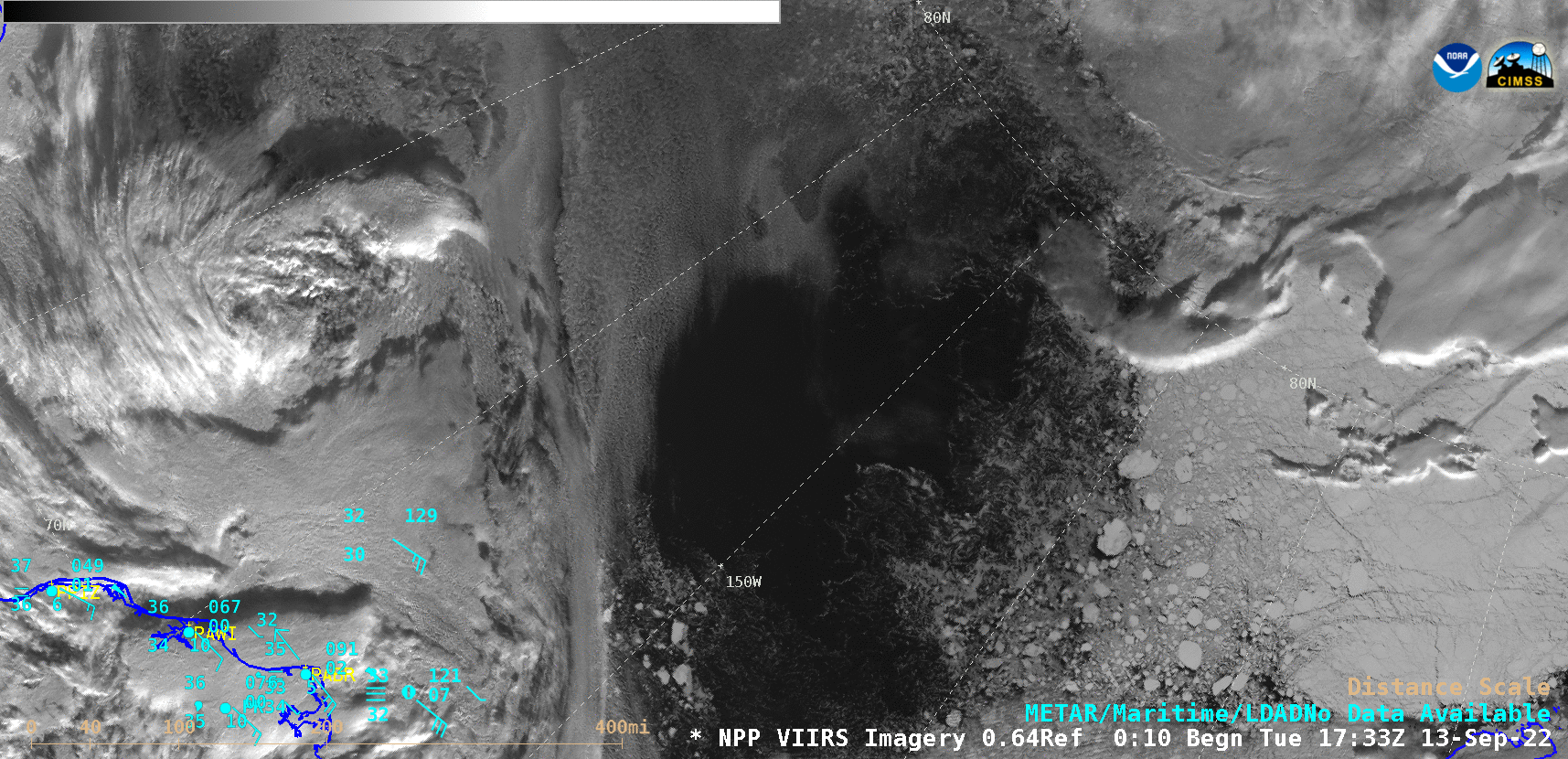
[ Archive ]

 |
CIMSS-NOAA Weekly Report [ Archive ] |
 |
CIMSS AND ASPB WEEKLY HIGHLIGHTS FOR THE WEEK ENDING SEPTEMBER 16, 2022
DATA, INFORMATION, AND USE-INSPIRED SCIENCE:
Simulation Produced of the Needed GeoXO Sounder Ensquared Energy: A set of simulations of the GeoXO Sounder (GXS) Ensquared Energy values were generated by scientists at the Cooperative Institute for Meteorological Satellite Studies (CIMSS). The results were presented on September 15, 2022 to the GXS working group, which is comprised of engineers, product and user scientists. The simulations, based in part on MODIS Airborne Simulator observations, helped confirm current instrument specifications. (Z. Li, CIMSS, 608-890-1982; T. Schmit, E/RA2, 608-263-0291, tim.j.schmit@noaa.gov)
 (Click image to enlarge)
(Click image to enlarge)
Figure: For these particular MODIS Airborne Simulator datasets, Ensquared Energy of 70% or more introduces pseudo noise less than assumed observation noise.
ProbSevere LightningCast Probabilities available for NWS Guam: In response to a request of William (Brandon) Aydlett, the Science and Operations Officer (SOO) at the National Weather Service Forecast (NWS) office on Guam, John Cintineo from the Cooperative Institute for Meteorological Satellite Studies (CIMSS) has created a Guam-centric sector for ProbSevere LightningCast Probabilities using Himawari-8 data. The product will be used in the forecast office for Airport Advisories and Warnings for lightning events and is available at https://cimss.ssec.wisc.edu/severe_conv/pltg.html under the Himawari-8 'Guam FD Subsect' sector. Details are presented on the CIMSS Satellite Blog: https://cimss.ssec.wisc.edu/satellite-blog/archives/47896. (J. Cintineo, S. Lindstrom, 608 263 4425; CIMSS)
FUTURE OUTLOOK:
AWARDS AND RECOGNITION:
TRAVEL AND MEETINGS:
CIMSS participation at the GLM Science Meeting: John Cintineo of the Cooperative Institute for Meteorological Satellite Studies (CIMSS) presented at the 2022 Geostationary Lightning Mapper (GLM) Science Meeting in Huntsville, AL. John's talk, "GLM use in the ProbSevere Products", highlighted the varied ways that GLM flash data is used in the ProbSevere convective-nowcasting artificial-intelligence (AI) models. GLM flash-extent density is used as a predictor in an image-based satellite-only model that identifies intense convection. Output from this model (IntenseStormNet) in turn serves as input to the ProbSevere v3 severe-weather nowcasting models, helping ProbSevere leverage the unique spatial and spectral attributes of GOES-R GLM and Advanced Baseline Imager (ABI). GLM data also serves as the truth variable for ProbSevere LightningCast, an AI model that predicts the probability of lightning (as observed by GLM) in the next 60 minutes for any given location. (J. Cintineo, CIMSS, cintineo@wisc.edu; M. Pavolonis, E/RA2, 608-263-9597, michael.pavolonis@noaa.gov; J. Sieglaff, CIMSS, justin.sieglaff@ssec.wisc.edu)
TRAINING AND EDUCATION:
MEDIA INTERACTIONS AND REQUESTS:
SOCIAL MEDIA AND BLOG Posts:
SSEC and CIMSS Scientists in the News: Scientists at the University of Wisconsin-Madison (UW) Space Science and Engineering Center (SSEC) and the Cooperative Institute for Meteorological Satellite Studies (CIMSS) provide expert interviews, imagery and case studies to promote science. This week: 1. This summer, William L. Smith received the International Radiation Commission's Gold Medal Award, recognizing contributions of lasting significance to the field of radiation research. Smith is a former director of CIMSS and professor emeritus in the UW-Madison Department of Atmospheric and Oceanic Sciences. SSEC News published this story: https://www.ssec.wisc.edu/news/articles/14656/. 2. CIMSS Satellite Blog contributors Scott Lindstrom and Scott Bachmeier published these case studies: "Unusually low ice concentration in the Beaufort Sea and Chukchi Sea" (Sept. 13), "Using NUCAPS profiles before Pyrocumulus events" (Sept. 11), "5.1 micrometers and IASI" (Sept. 11), "Pyrocumulonimbus clouds in Oregon, Idaho and California" (Sept. 10) and "CSPP Geosphere views of smoke in Oregon and Idaho" (Sept. 9). Read more at the CIMSS Satellite Blog: https://cimss.ssec.wisc.edu/satellite-blog/. (W. Smith, SSEC, S. Lindstrom, CIMSS, S. Bachmeier, CIMSS, J. Phillips, SSEC, 608-262-8164)
 (Click image to enlarge)
(Click image to enlarge)
Figure: Suomi-NPP VIIRS images showed a large area of ice-free water in the Western Beaufort Sea and Eastern Chukchi Sea on August 13, 2022, with limited sea ice concentration as far north as 80 degrees north latitude. Read more at the CIMSS Satellite Blog: https://cimss.ssec.wisc.edu/satellite-blog/archives/47906. Credit: CIMSS, NOAA.
PUBLICATIONS:
OTHER:
| Archived Weeklies Page | Submit a report item |